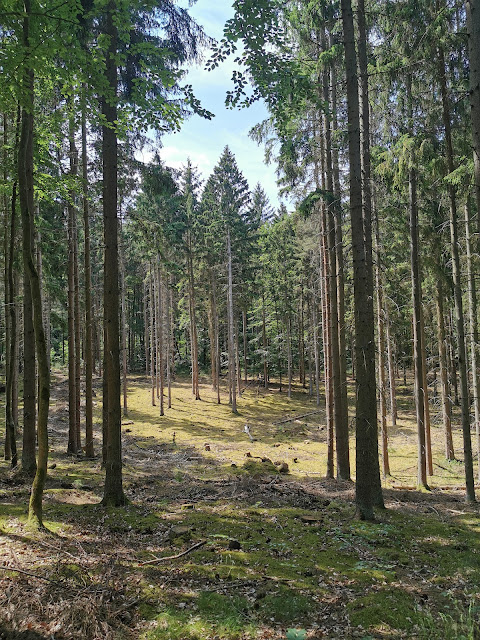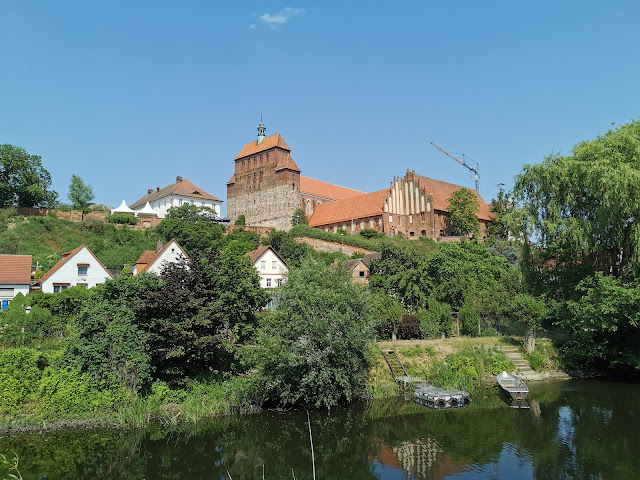On a sunny weekend day in mid-June, I decided to visit a couple of cities southwest of Berlin. I took a train and then reached the city of Magdeburg, and as I had a long layover before my next train, I decided to head through the city center and visit the Cathedral once again. Unfortunately, as I got there I found it closed, and decided I would come back later on my return. After getting back to the train station I took a ride to the first town on the trip, Königslutter am Elm. Once there I first traversed the pretty old town on foot, admiring the nice timber-framed architecture typical of this town. After walking some streets I reached the southern end of town where I then proceeded to visit the Kaiserdom, a former Benedictine abbey church later turned into an Imperial Cathedral. The building was in fact founded in 1135 by the Holy Roman Emperor Lothair III, in a Romanesque style, and is one of the largest buildings in Northern Germany measuring 75m in length and 18m in height. The cathedral was inspired by medieval Italian models with an active presence of Comacine masters, such as a certain Nicolaus of Verona. The influence of these masters can be seen especially in the execution of the portals and the decorative relief apparatus, which has parallels in Italian religious buildings in the cities of Verona, Piacenza, and Modena. Another characteristic feature of this building is the presence of the Westwerk, an architectural construction typical of the medieval world in the Carolingian tradition. The interior quite simple in style, as is typical in Romanesque architecture, was refurbished and painted during the 19th century giving it a more modern look. At the center of the nave were the tombs of Lothar, his wife Richenza, and their son-in-law Henry X. I also visited the annexed cloister, with beautiful columns and decorated capitals. Once I was done visiting the cathedral I exited the building and went around it admiring its beautiful romanesque structure, with the decorated friezes, holding animal and anthropomorphic figures, and the portal with the two stone lions, typically influenced by those found in Northern Italian cathedrals. Walking back through town I then stopped at the main square with its picturesque building around its perimeter. On the northern end of the square was the town hall, and behind it, the Stadtkirche, a 12th-century church, renovated during the 18th century but which kept its original Romanesque stone tower. After the visit to the church I then headed to the train station where I took a ride to the nearby city of Helmstedt. Once there I first directed myself to the church of St Stephen, a gothic three-aisled basilica from the 14th century. Its interior mostly held Renaissance and Baroque furniture and decoration, such as the pulpit, altar, and organ, and also featured a striking brass baptismal font from 1590. Once outside the church, I continued on my walk passing by some nice old houses, many of which with decorated timber framings. I then reached the main square surrounded by buildings, including the neo-renaissance town hall from 1906. Continuing onwards I passed a picturesque street with more timber-framed houses and then came upon the Juleum, a late 16th century Weser Renaissance building. This used to be the lecture hall and library building of the Helmstedt University, a university which existed from 1576 until 1810. Unfortunately, the whole building was covered in scaffolding so I could not appreciate its beautiful architecture. Moving on I walked through some side streets, passing then under the nice Hausmannsturm, d the only surviving city gate of Helmstedt, once part of the medieval fortifications that encircled the old town. Once outside the city center, I walked westwards for a few minutes until I reached the Kloster Marienberg, a former Augustinian monastery. Located on a small hill, it was founded in the 12th century and still features a mostly Romanesque look with some Gothic additions, particularly in the apse, and later modifications such as the tower and interiors. Nowadays it is used by an evangelical congregation and was closed during my visit. Back in the city center, I continued my visit, passing by a house where the Italian philosopher and cosmological theorist Giordano Bruno, lived during his time teaching at the University of Halmstedt. Walking on I then reached another important monastery, the Kloster St. Ludgeri. This former Benedictine abbey was founded by St Ludger in 800 A.D. and held much power and land, extending in a large area just east of the old town of Helmstedt. Nowadays, much of its grandeur was lost and a road cuts right through its middle, next to the main church building. It is used by a catholic congregation and holds offices so I could not visit the surviving Romanesque church itself unfortunately. Another surviving feature of the former monastery complex is the Türkentor, a triumphal arch that once served as the main entrance built in 1716 to celebrate the victory over the Ottomans by Prince Eugene of Savoy at the Battle of Petrovaradin. It was then time to head back to the station, which I reached shortly after so that I could take the next train to Magdeburg. Once there, as I had to wait for the next one to Berlin, I decided to try again to visit the cathedral. I found it open this time and once again visited this striking gothic cathedral, one of the nicest north of the Harz. After the wonderful visit, I headed back to the train station finally able to reach Berlin.
 |
| A street in the old town of Königslutter am Elm |
 |
| The interior of the Kaiserdom |
 |
| Decorations inside the church |
 |
| The cloister |
 |
| View of the westwerk from the cloister |
 |
| View of the imperial cathedral |
 |
| A timber-framed house |
 |
| The Am Markt |
 |
| A street in the old town of Helmstedt |
 |
| The interior of the St Stephani church |
 |
| Another view of the old town |
 |
| A street with timber-framed houses |
 |
| Another street in the old town |
 |
| The Hausmannsturm |
 |
| The Kloster Marienberg |
 |
| Yet another street in the old town |
 |
| The Helmstedt university buildings |
 |
| The main square |
 |
| Another view of the main square |
 |
| The Madgeburg Cathedral |























































